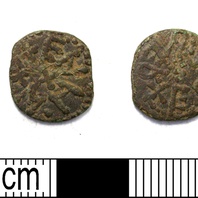
Viking Objects
Northumbrian Styca (LEIC-0D9D6F)
This Northumbrian styca was probably minted in the name of Æthelred II of Northumbria possibly by the moneyer Eanwulf. While Wessex and Mercia were using silver coinage as part of their monetary economy, Northumbria was using copper coins known as stycas, which may have contained trace amounts of silver. The concentration of these coins at sites such as Torksey and ARSNY (‘a riverine site near York’) suggests that they could have remained in circulation after the fall of Northumbria in 866 but were taken to these sites by the Vikings during their campaigning. This particular example was likely brought to Nottinghamshire from Northumbria by means of the Great Army’s overwintering activities in and around Nottingham.
Read More
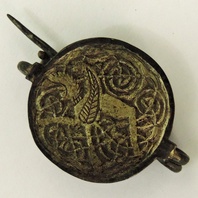
Viking Objects
Silver Gilt Brooch (1989-58/7224)
A circular silver gilt plate brooch with chip carved decoration of a winged creature. The creature may be a griffin. It is enmeshed in fine spiralling interlace. The reverse features a U-shaped catchplate and pin with a spring. This decoration is Mercian in style. For more information on Scandinavian jewellery in England check out our blog: Brooches, Pendants and Pins: Scandinavian Dress Accessories in England.
Read More
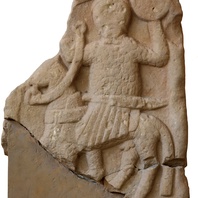
Viking Objects
Repton Stone (1989-59/1165)
The Repton Stone, as it is now known, was found in a pit near the eastern window of the Church of St Wystan, Repton, Derbyshire in 1979. It was originally carved on all four faces, but recognisable detail remains only on two of them. The Repton Stone is a section of a sandstone cross shaft carved on one side with a mounted armed figure (Face A), on the other with a monstrous creature eating the heads of two people (Face B). It was broken Face A: A moustachioed armed figure on horseback with sword and shield raised in the air is carved on this face. The horse is very clearly a stallion. Incised decoration, where the design is scratched into the surface, shows that the rider was depicted wearing armour and carrying a second weapon at his waist, perhaps a seax (knife or dagger). The armour was probably intended to be mail although the carving suggests scale. The mounted man appears to be wearing a diadem, suggesting that he was of high rank. He is wearing a pleated tunic under his armour, and has cross-gartered legs. The reins of the horse are looped over his right arm. Elements of the tack are clearly visible. Face B: This face would have been on the side of the cross. The monstrous creature on this face consists of a snake-like body with the face of a human being. The serpent beast appears to be devouring the heads of the two human figures that embrace in front of it. The serpent may be a representation of the Hellmouth devouring souls. The pit the stone was found in probably dates to the eleventh century or early twelfth century. However, the cross was probably much earlier in date, being broken up close to the time it was deposited in the pit. It is probable that the cross was made before the Viking camp in 873/4 because the monastery that stood on this site before the Vikings was not refounded after the Vikings adopted Christianity. The presence of this cross at the site of a Viking camp shows that Repton was an important place before the Vikings made it their temporary abode. This may have been one reason that the Vikings chose Repton for one of their camps, although its proximity to the River Trent would also have been an important factor. The Vikings used waterways to access the interior of the country, so it is not surprising to find their winter camps beside navigable rivers.
Read More
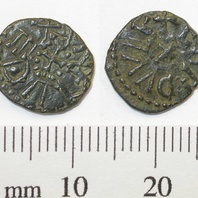
Viking Objects
Northumbrian Styca (DENO-87CE96)
This copper-alloy styca was minted by the moneyer Eardwulf in the name of King Ethelred II of Northumbria during his second reign. While Wessex and Mercia were using silver coinage as part of their monetary economy, Northumbria was using copper coins known as stycas, which may have contained trace amounts of silver. The concentration of these coins at sites such as Torksey and ARSNY suggests that they could have remained in circulation after the fall of Northumbria in 866 but were taken to the sites by the Vikings during their campaigning. they were not much use to the Vikings within their silver-based bullion economy but it is suggested that they were treated as raw material and were used as commodity money instead. The evidence for the production of copper-alloy strap-ends at Torksey and ARSNY supports this idea that the stycas were used for production.
Read More
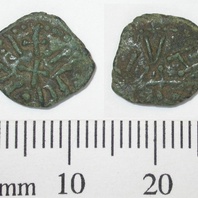
Viking Objects
Northumbrian Styca (DENO-EF4544)
The blundered legends on this example suggest it is an imitation of stycas minted for a Northumbrian ruler or the Archbishops of York. While Wessex and Mercia were using silver coinage as part of their monetary economy, Northumbria was using copper coins known as stycas, which may have contained trace amounts of silver. The concentration of these coins at sites such as Torksey and ARSNY suggests that they could have remained in circulation after the fall of Northumbria in 866 but were taken to the sites by the Vikings during their campaigning. They were not much use to the Vikings within their silver-based bullion economy but it is suggested that they were treated as raw material and were used as commodity money instead. The evidence for the production of copper-alloy strap-ends at Torksey and ARSNY supports this idea that the stycas were used for production.
Read More
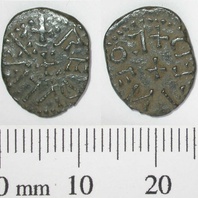
Viking Objects
Northumbrian Styca (DENO-60AFD2)
This copper-alloy styca was probably minted by the moneyer Coenred in the name of King Redwulf of Northumbria. While Wessex and Mercia were using silver coinage as part of their monetary economy, Northumbria was using copper coins known as stycas, which may have contained trace amounts of silver. The concentration of these coins at sites such as Torksey and ARSNY suggests that they could have remained in circulation after the fall of Northumbria in 866 but were taken to the sites by the Vikings during their campaigning. They were not much use to the Vikings within their silver-based bullion economy but it is suggested that they were treated as raw material and were used as commodity money instead. The evidence for the production of copper alloy strap-ends at Torksey and ARSNY supports this idea that the stycas were used for production.
Read More
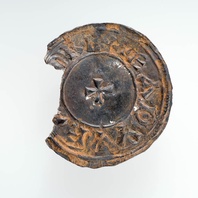
Viking Objects
Edward the Elder Penny (CM.615-1998)
A Horizontal type (HC1) silver penny of Edward the Elder (874-924), son of Alfred the Great, and minted by a moneyer called Beornwald. This coin was part of a hoard of twelve coins found at Thurcaston between 1992 and 2000. The coins are Anglo-Saxon, Arabic and Viking issues, and show the diverse and wide-ranging contacts between societies at this time. The hoard was probably deposited c.923-925, approximately five years after Leicester had been retaken by Mercia (c.918). They indicate that a bullion economy was still operating in the Danelaw as late as the 920s. This suggests that the reconquest did not immediately manage to institute Anglo-Saxon practices such as a monetary economy.
Read More
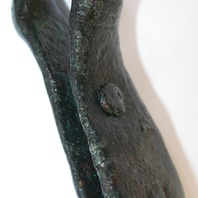
Viking Objects
Suspension Loop (1985/225-1)
This copper-alloy suspension loop was found in Mound 1 at Heath Wood, Ingleby and was probably part of a sword belt. The loop is wide enough for a doubled strap to pass through, so it may have been used to suspend the scabbard from the belt. It has been suggested that this one was probably Anglo-Saxon in origin, because this style is not known from Scandinavia, but that did not stop a Viking acquiring it and being buried with it.
Read More
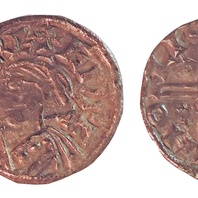
Viking Objects
Northumbrian Penny (NLM-0D491E)
This silver penny was minted in the name of King Eanred of Northumbria. The obverse shows a possibly helmeted and cuirassed individual and reads +EANRE AD RE; the initial cross doubles as X. The reverse reads +CO/ER/[?I]/HO/LI. This particular example was likely brought to Nottinghamshire from Northumbria by means of the Great Army’s overwintering activities in and around Nottingham.
Read More
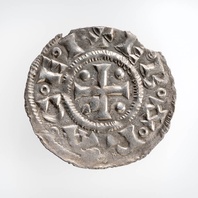
Viking Objects
Northumbrian Viking Penny (CM.952-2000)
This Sword St. Peter type silver penny is not associated with any particular ruler but was minted in the Viking kingdom of Northumbria. The coin features a sword image which is usually considered to represent the sword of St Peter, whose name features on the same side of the coin, and a hammer which is often taken to be Thor’s hammer, thus mixing the iconography of the Christian and Norse religions. It was found as part of the Thurcaston hoard which was probably buried c.923-925 CE, approximately five years after Leicester had been retaken by Mercia (c.918). The coins in the hoard are Anglo-Saxon, Arabic and Danelaw issues, showing the wide-ranging contacts between societies at this time. After the establishment of the Danelaw, some Viking leaders decided to mint their own coins to solidify their legitimacy in the eyes of the local populace. This created a hybrid economy where some members of the Danelaw used bullion and others used coins. The bullion economy resulted in some coins being cut into pieces to pay for items.
Read More
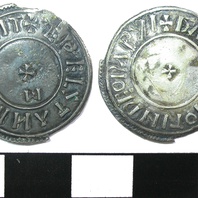
Viking Objects
Silver Penny (1914/543-1)
This silver penny of King Aethelstan, who was King of England from 927-939, was minted in Derby by the moneyer Gadierd between 937-939. It is not known where it was found. Moneyers were people who were permitted to mint money on behalf of the king. Minting coins was a way of controlling the means of exchange within a kingdom and which created a more easily administered standardized system of trade. Moreover, the coins themselves were often used as propaganda, portaying symbols and statements that gave off a desired message. The Vikings later used the minting of coins to legitimize their own rule.
